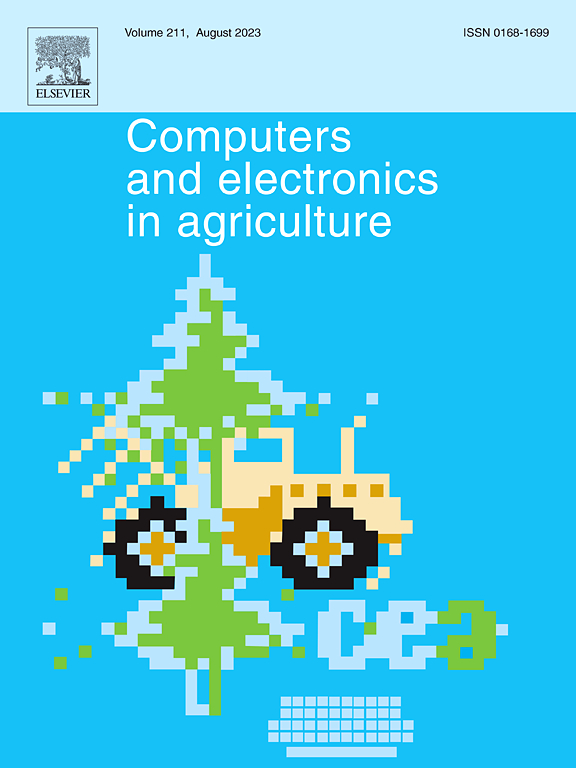Comparison between different major data assimilation algorithms on region tobacco growth simulation
IF 7.7
1区 农林科学
Q1 AGRICULTURE, MULTIDISCIPLINARY
引用次数: 0
Abstract
While tobacco plays a significant role in the global economy, research on regional tobacco growth simulation remains limited. This study integrates the WOFOST crop model with satellite remote sensing data, focusing on the data assimilation (DA) of leaf area index (LAI) to enhance the accuracy of regional tobacco growth simulations. Field survey data were used for model calibration, providing the foundation for the analysis. The performance of four 4-Dimensional Variational Assimilation algorithms (4DVAs)—Particle Swarm Optimization (PSO), Simulated Annealing (SA), Shuffled Complex Evolution-University of Arizona (SCE-UA), and Gray Wolf Optimization (GWO)—was compared with four sequential DA algorithms (SDAs)—Ensemble Kalman Filter (EnKF), Ensemble Variational (EnVar), Ensemble Square Root Filter (EnSRF), and Particle Filter (PF). The 4DVAs were developed by integrating constraint DA Algorithms (CDAs) into the 4D-Var framework, enhancing their capability to optimize model states over a time window. Additionally, the performance of their coupled DA algorithms was evaluated. The results indicated that the coupled of SA and PF (SA-PF) achieved the best performance in terms of model accuracy. Compared to field survey data for biomass, stem mass and leaf mass, our method achieved the coefficient of determination (R2) values of 0.89, 0.86, and 0.81, respectively, with normalized root mean square error (NRMSE) values of 0.12, 0.10, and 0.09. The SA-PF coupling algorithm also performs better than some new DA algorithms. This study provides a valuable reference for regional tobacco growth simulation and data assimilation, improving the accuracy and applicability of crop growth models.
不同主要数据同化算法在区域烟草生长模拟中的比较
虽然烟草在全球经济中发挥着重要作用,但对区域烟草增长模拟的研究仍然有限。本研究将WOFOST作物模型与卫星遥感数据相结合,重点研究叶面积指数(LAI)的数据同化(DA),以提高区域烟草生长模拟的准确性。利用野外调查数据进行模型标定,为分析提供基础。将粒子群优化(PSO)、模拟退火(SA)、亚利桑那大学shuffle Complex Evolution-University - of Arizona (SCE-UA)和灰狼优化(GWO) 4种4维变分同化算法(4DVAs)与4种顺序数据分析算法(sda)——集合卡尔曼滤波(EnKF)、集合变分滤波(EnVar)、集合平方根滤波(EnSRF)和粒子滤波(PF)的性能进行比较。4dva是通过将约束数据分析算法(cda)集成到4D-Var框架中开发的,增强了它们在一个时间窗口内优化模型状态的能力。此外,还对它们的耦合数据分析算法的性能进行了评价。结果表明,SA和PF的耦合(SA-PF)在模型精度方面取得了最好的性能。与野外调查的生物量、茎质量和叶质量数据相比,该方法的决定系数(R2)分别为0.89、0.86和0.81,标准化均方根误差(NRMSE)分别为0.12、0.10和0.09。SA-PF耦合算法的性能也优于一些新的数据分析算法。本研究为区域烟草生长模拟和数据同化提供了有价值的参考,提高了作物生长模型的准确性和适用性。
本文章由计算机程序翻译,如有差异,请以英文原文为准。
求助全文
约1分钟内获得全文
求助全文
来源期刊

Computers and Electronics in Agriculture
工程技术-计算机:跨学科应用
CiteScore
15.30
自引率
14.50%
发文量
800
审稿时长
62 days
期刊介绍:
Computers and Electronics in Agriculture provides international coverage of advancements in computer hardware, software, electronic instrumentation, and control systems applied to agricultural challenges. Encompassing agronomy, horticulture, forestry, aquaculture, and animal farming, the journal publishes original papers, reviews, and applications notes. It explores the use of computers and electronics in plant or animal agricultural production, covering topics like agricultural soils, water, pests, controlled environments, and waste. The scope extends to on-farm post-harvest operations and relevant technologies, including artificial intelligence, sensors, machine vision, robotics, networking, and simulation modeling. Its companion journal, Smart Agricultural Technology, continues the focus on smart applications in production agriculture.
 求助内容:
求助内容: 应助结果提醒方式:
应助结果提醒方式:


